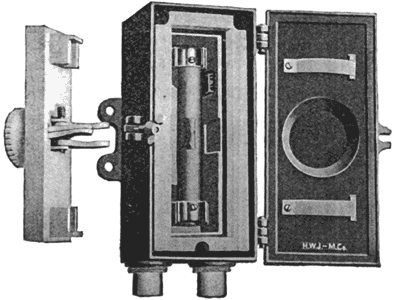[Trade Journal]
Publication: Western Electrician
Chicago, IL, United States
vol. 35, no. 18, p. 355, col. 2-3
New Pole-line Fuse Box.
The H. W. Johns-Manville Company of New York is placing on the market a new pole-line fuse box known as the Sachs-Noark fuse box, which is shown in the accompanying picture. The box is designed for 2,500 volts and will protect the insulation of the current-carrying parts from the weather and also allow of the maximum amount of insulation to be used. The external casing consists of a cast-iron box having a hinged cover, opening sideways. The cover is provided with a rubber gasket, which forms a weather seal between the box proper and the cover, which latter is firmly held in position by the thumb-nut hasp. Inside of the iron box is a porcelain box provided with a porcelain cover and fuse holder. When in place the cover is flush with the top surface of the porcelain box and finds a seat on a rubber gasket placed in a ledge around the inside of the outer walls of the porcelain box. After the wire once enters the porcelain bushing on the bottom of the box it is entirely surrounded by porcelain and is perfectly protected from leakage or contact with the non-current-carrying parts of the box.
The fuse is held to the cover by means of a "lobster-claw" device, which consists of a pair of tongs made of a specially treated insulating material, manipulated so as to clamp or release the fuse by means of a nut embedded in the porcelain handle, on the exterior of the cover. This nut works on a stud projecting from the clevis to which the claws are attached. Turning the nut in one direction causes the claws to be brought together to clamp the fuse, so that it is firmly held to the blocks on the porcelain cover. Movement in the opposite direction permits the spring to open the claws and release the fuse. When clamped to the cover, the fuse and cover are manipulated as one device and form practically a plug, co-acting with the contacts attached to the base portion of the porcelain box. The fuses are fitted with contacts, which consist of flat blades on each side of the fuse tube, forming a knife-blade switch contact. The receiving clips on the base of the porcelain box are made of spring metal of ample conductivity, and the insertion of the fuse into them is readily accomplished; not only due to the rounded corners of the clips, but also because the cover telescopes onto the block until it finds its seat on the rubber gasket.
 |
| New Pole-Line Fuse Box. |
The arrangement is such that the box is practically closed just before the fuse reaches the contact clips. The fuse may, therefore, blow while being inserted into the clips without injury to the person who may be handling the porcelain knob on the outside of the cover.
